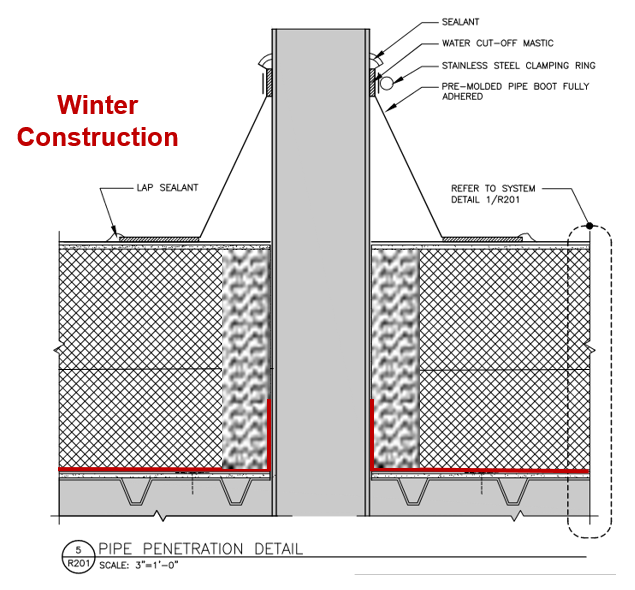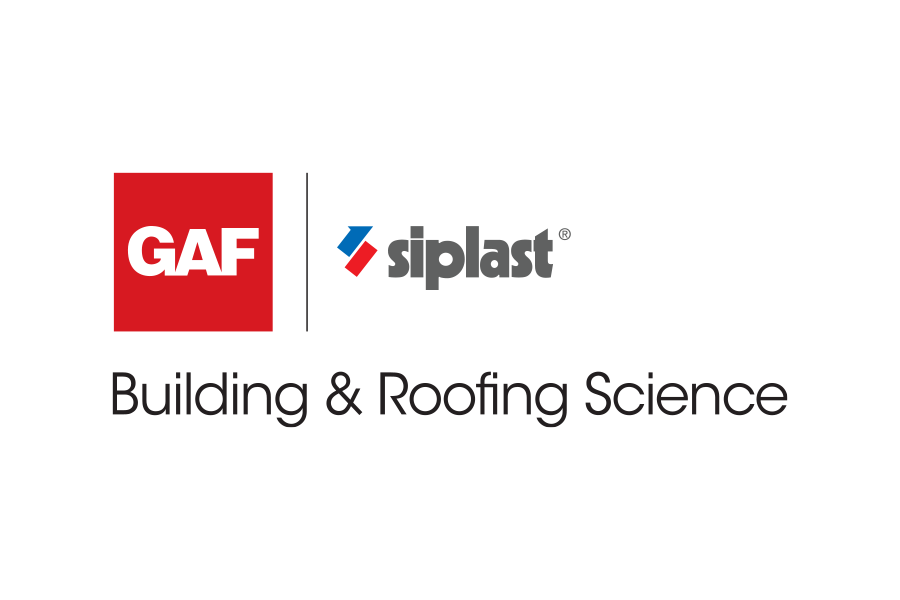Roofs for Cold Storage Buildings
Winter Construction
During new construction of a cold storage building, construction-generated moisture can move up into the roof system. This moisture can come from curing of concrete floors and roof decks, the use of propane heaters, and/or ambient humidity and rain. If the moisture is trapped in the roof system, the bottom portions of the insulation can freeze during operation. This concern warrants the use of an air barrier/vapor retarder at the deck level to keep construction-generated moisture out of the roof system. However, an air barrier that is vapor open (a Class III or higher vapor retarder) will allow some drying potential during operation of the building while preventing moisture-laden air from getting up into the roof system during construction. Figure 16 shows an example of this.

Graphic adapted from Roof Spec Inc.
FIGURE 16: Shown is a vapor retarder installed as an air barrier to help prevent construction-generated moisture from infiltrating the roof system.
Also, simply due to cold temperatures, especially with interior spaces below minus 32 degrees Fahrenheit, adjacent materials can become frozen, regardless of air and vapor control. It’s singularly a temperature issue. To that end, the bottom portions (perhaps an inch or two) of insulation can, over time, become frozen, resulting in an effective R-value of zero as well as creating reroofing issues when trying to remove frozen insulation.
Reroofing Concerns
Reroofing a cold storage building provides a unique opportunity to identify and address air and vapor leaks that may be occurring. This is a critical step for long-term success and proper performance not only of the roof but also the building itself. This is the benefit of a reroofing project—problems can be located and solutions determined prior to reroofing.
According to the requirements of the building code, wet insulation is required to be removed prior to reroofing (for re-covering and replacement projects). Frozen insulation is ‘wet’ and has little, if any, insulating value. Most commonly, frozen insulation is located just above the deck. This may also be indicative of some level of moisture intrusion into the roof system. The lowest layers of insulation are also the coldest; they are adjacent to the cold portion of a cold storage building. Determining the source of moisture and addressing the issue (e.g., including a Class III vapor retarder at the deck level) can improve the thermal- and moisture-control performance of the roof and the entire building.
Testing
The air-barrier-control layer can be tested as a material, system or whole building according to the International Energy Conservation Code. For cold storage buildings, it’s prudent to use whole building air-leakage testing as a measure to ensure the enclosure air leakage is minimized to save energy, prevent moisture (or ice) accumulation and enable the refrigeration system to perform as intended.
In general, whole-building air-leakage tests should be performed when the air-control layer is exposed and repairable without significant deconstruction. Therefore, timing of a whole-building air-leakage test is critical because it’s extremely difficult and expensive to deconstruct a completed building and then repair the air-control layer. For cold storage buildings, the timing concern is less critical because the roof membrane and the exterior wall skin is the air-control layer.
In Summary
Avoiding thermal bridging by using adhered membranes and adhered upper layers of insulation, with only the bottom layer(s) mechanically attached, allows for a more effective thermal layer. Reduce or eliminate air leakage across the building enclosure to reduce the potential for moisture gain, condensation and freezing of insulation, as well as heat loss that is associated with air infiltration and exfiltration. Details make all the difference in this case. Consider expansion and contraction potential as well as differential movement when designing the details at interfaces and penetrations to extend the service life and functionality of the roof’s details.
And finally, cold storage buildings are unique because of their low interior temperatures and the resulting vapor drive and significant potential for air infiltration. Taking into account the science of heat, air and moisture movement when designing the roof system for a cold storage system is paramount for long-term success.
END NOTES
1 “Energy Modeling Guideline for Cold Storage and Refrigerated Warehouse Facilities.” International Association for Cold Storage Construction and International Association of Refrigerated Warehouses. 19 December 2013. Web. 23 June 2020.
2 Zhivov, Alexander and Herron, Dale. “Improvement of Air Tightness in U.S. Army Buildings.” Journal of Building Enclosure Design. Summer 2011. Web. 23 June 2020.
3 ”Cleaning the Air on Air Barriers: A Guide to Air Barriers in Commercial Low-Slope Roof Assemblies.” GAF Technical Services. April 2018. Web. 23 June 2002.
4 Kirby, James R. “Air Barriers and Vapor Retarders: The Current Conundrum in the Roofing Industry.” GAF Blog. 10 September 2018. Web. 23 June 2020.
5 “Energy Modeling Guideline for Cold Storage and Refrigerated Warehouse Facilities.” International Association for Cold Storage Construction and International Association of Refrigerated Warehouses. 19 December 2013. Web. 23 June 2020.
6 Hardy Pierce, Helene and Crowe, Joan P. “Structural Concrete Decks, Vapor Retarders, and Moisture – Rethinking What We Know.” Interface Magazine. February 2020. Web. 23 June 2020.
7 Gatto, Kip; Wong, Grace; and Klaboe, Kari. "Assessing Concrete Moisture in Unconditioned Environments.” Proceedings from the 33rd RCI International Convention and Trade Show. March 2018. Web. 23 June 2020.
8 “A Guide to Cold Storage Roof System Design.” GAF. November 2019.
9 Taylor, Thomas J.; Willits, James; Hartwig, Christian A.; and Kirby, James R. “Insulation Value Optimization for Low-Slope Roofs.” RCI Building Envelope Technology Symposium. November 2018. Web. 23 June 2020.
10 Meyer, Benjamin. “Parapets Part 1: Continuity of Control Layers.” GAF Blog. 27 September 2019. Web. 23 June 2002.
James R. Kirby, AIA, is a building and roofing science architect for GAF who provides building and roofing science information via seminars and articles to architects, consultants and the roofing industry at-large.









